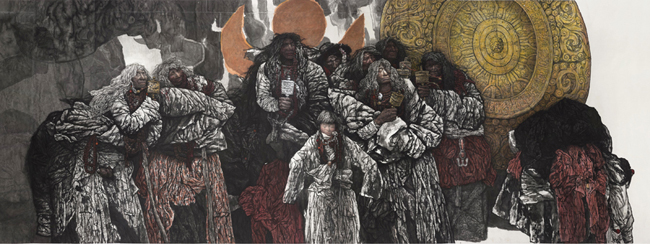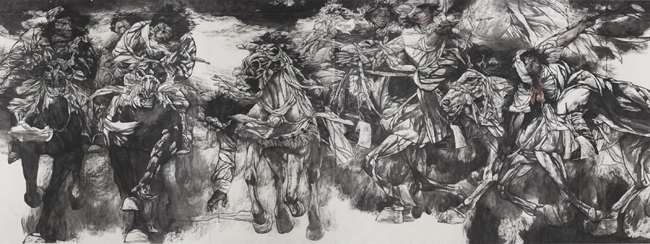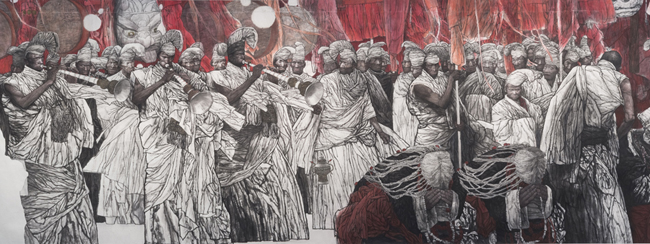Author: Lin QiSource: China DailyPublished on: 2019-10-15

Sacred Mountains, painting from Li Bo'an's Out of Bayan Har series, is among Li's works on show at the eponymous exhibition at the Tsinghua University Art Museum.
Li Bo'an might not be a household name in China, but his artistic legacy is nothing short of epic in its scale and beauty, Lin Qi reports.
In 1998, when Li Bo'an died at age 54, he was close to completing the 10th and final painting of an ambitious series of landscapes, depicting both the breathtaking views of western China and the dynamic lives of ethnic Tibetans.
Li, a self-taught painter and senior editor of Henan People's Fine Arts Publishing House, in Zhengzhou, Henan province, had been working on the project for a decade. He had traveled three times to the provinces of Qinghai and Gansu, visiting Tibetan communities to sketch and painstakingly collect materials for the series.
The collection, titled Out of Bayan Har, measures a total length of 124 meters, revealing not only a panoramic of the Bayan Har Mountains but also the rich history and culture of the Tibetans who live there. Li also wanted to hail the vibrancy of Chinese history and the spirit of its people. He had planned four other similar series of long-scroll paintings, each tracing the history of the Hui, Mongolian, Manchu and Han ethnic groups. Together with Out of Bayan Har, they would have formed a national epic.

Horse Racing, painting from Li Bo'an's Out of Bayan Har series, is among Li's works on show at the eponymous exhibition at the Tsinghua University Art Museum.
Sadly, Li succumbed to illness before he was able to finish his artistic odyssey. Out of Bayan Har was his only major legacy.
Out of Bayan Har was donated by Li's family to the Tsinghua University Art Museum in early September and is on show at an eponymous exhibition at the museum through Oct 20.
The collection of 10 themed paintings, produced in colored ink on paper, blends the styles of classic Chinese ink art and Western oil paintings. It portrays more than 200 Tibetans in different scenarios — such as embarking on a pilgrimage, presenting khata (a traditional Tibetan ceremonial scarf), performing Tibetan Opera and horse racing — that unfold a magnificent view of various aspects of life on the Qinghai-Tibet Plateau.
Li painted men and women, young and old, opera performers, Tibetan Buddhist monks and galloping horses. He accentuated people's strong bodies, calluses on their hands and the hardened outlines of their faces to convey a spirit of freedom, dynamism and honesty.

Du Pengfei, deputy director of the Tsinghua museum, says: "Li toiled hard to pursue his artistic dream and yet, he was little known or acknowledged. What a great pity. Luckily, his spirit will live on, being encapsulated in Out of Bayan Har."
Li did not receive any formal artistic training. He failed postgraduate entrance examinations to art academies. However, he taught himself the basics of Chinese ink painting, oil painting, watercolor, gouache and illustration. His work at the publishing house allowed him frequent contact with artists and scholars, who helped him improve his skills.
Li gradually focused on painting traditional Chinese portraits, an endeavor from which the concept of Out of Bayan Har grew.

Su Dan, deputy director of the Tsinghua museum, says that Out of Bayan Har is a unique body of work.
"It shows imposing snowy mountain peaks, mighty clouds, majestic temples and crowds of people. And it presents a sense of the mysterious, extensive space in which culture, religion and humanity crisscross".
Xu Jianguo, a close friend of Li and a professor at Tsinghua University's Academy of Arts and Design, says that on an individual level, the paintings embody the hardships, torments and meditations Li once endured himself. "By hiding these sentiments behind the landscapes and people's faces in his paintings, Li ascended to a higher level to hail the spirit of persistence."